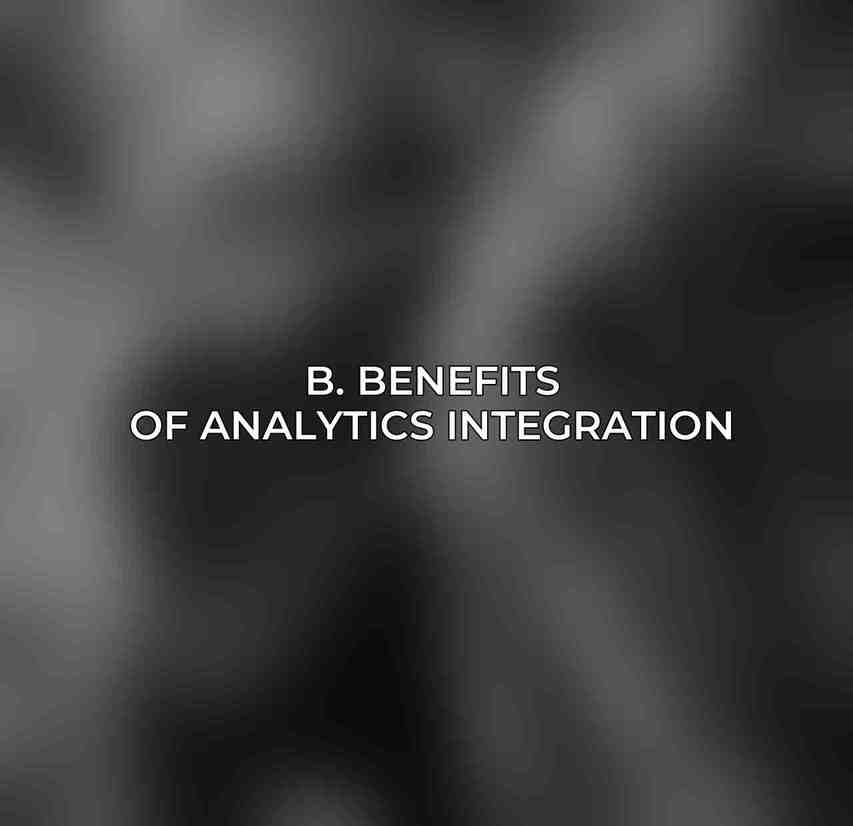Analytics integration plays a crucial role in modern data-driven businesses. By seamlessly connecting various data sources and analytical tools, organizations can harness valuable insights to drive informed decisions and optimize their operations. Understanding the types of analytics integrations and their benefits is essential for maximizing the potential of data-driven strategies.
A. Types of Analytics Integrations
Customer Relationship Management (CRM)
- Integrating CRM systems with analytics platforms allows businesses to consolidate customer data, track interactions, and analyze customer behavior to improve relationships and drive sales.
Marketing Automation
- Connecting marketing automation tools with analytics solutions enables companies to track campaign performance, understand customer preferences, and personalize marketing efforts for better ROI.
E-commerce Platforms Get the scoop on our perspective regarding Top Integration Tools for Seamless Analytics in 2024
- Integration with e-commerce platforms helps in analyzing online sales data, monitoring customer behavior, and optimizing product offerings to enhance the shopping experience and boost revenue.
B. Benefits of Analytics Integration

Analytics integration offers a plethora of advantages for businesses seeking to leverage data effectively:
Improved Data Accuracy and Consistency
“Integrating analytics ensures that data is centralized, standardized, and up-to-date for accurate analysis and decision-making.”
Enhanced Data Analysis and Reporting
“By combining diverse data sources, organizations can gain deeper insights, identify trends, and generate comprehensive reports for better strategic planning.”
Automated Data Collection and Processing
“Integration streamlines the collection and processing of data, reducing manual effort, minimizing errors, and enabling real-time analysis for quick decision-making.”
Optimized Marketing and Sales Strategies
“By integrating analytics with marketing and sales systems, businesses can tailor strategies based on data-driven insights, target the right audience, and drive revenue growth.”
Step-by-Step Guide to Analytics Integration
Achieving successful analytics integration requires a systematic approach that encompasses several key steps:
A. Define Integration Goals and Objectives
Before embarking on integration efforts, organizations should clearly outline their objectives, determine what insights they seek to gain, and establish measurable goals for the integration process.
B. Select Compatible Analytics Tools and Systems
The next step involves identifying and selecting analytics tools and systems that are compatible with existing infrastructure and capable of meeting the organization’s data integration requirements.
C. Plan Data Extraction and Transformation
Data extraction involves retrieving information from various sources, while transformation ensures that data is formatted, consolidated, and cleaned to facilitate meaningful analysis and insights.
D. Set Up Data Connectors and Integrations
Setting up data connectors and establishing seamless integrations between different systems is critical for enabling the smooth flow of data and ensuring interoperability for analytics purposes.
E. Test and Monitor Integration Performance
After implementation, thorough testing and continuous monitoring of integration performance are essential to identify and rectify any issues, ensure data accuracy, and optimize the integration for optimal results.
Integration Best Practices
Implementing analytics integration best practices can help organizations streamline their processes and maximize the value of their data assets:
A. Choose a Data-Driven Approach
Embracing a data-driven culture ensures that decisions and strategies are backed by insights derived from integrated analytics, fostering a more informed and agile organization.
B. Use Standardized Data Models and Metrics
Standardizing data models and metrics across integrated systems promotes consistency, facilitates cross-system analysis, and enhances the accuracy and reliability of insights.
C. Employ Data Governance and Security Practices
Prioritizing data governance and security safeguards the integrity, confidentiality, and compliance of data throughout the integration process, protecting against unauthorized access and misuse.
D. Conduct Regular Data Quality Checks
Regularly assessing and improving data quality through audits, validations, and cleansing processes is vital to maintaining the integrity and relevance of integrated data for decision-making.
Common Integration Challenges

Despite the benefits, organizations often encounter various challenges when implementing analytics integration strategies:
A. Data Privacy and Security Concerns
Protecting sensitive data and ensuring compliance with data protection regulations present significant challenges, requiring robust security measures and privacy controls.
B. Data Integrity and Consistency Issues
Maintaining data integrity, consistency, and quality across diverse sources and systems can be challenging, leading to discrepancies, errors, and unreliable insights.
C. Lack of Technical Expertise and Resources
Shortage of skilled professionals and resources capable of handling complex integration processes and resolving technical issues can impede the success of integration initiatives.
D. Siloed Data and Fragmented Systems
Organizational silos and disparate data systems hinder seamless integration, leading to data fragmentation, duplication, and a lack of unified insights for decision-making.
Stay tuned for the continuation of the Ultimate Guide to Analytics Integration Solutions, where we delve into advanced integration strategies, case studies, future trends, and valuable resources for further learning in the domain of analytics integration.
Frequently Asked Questions
What are analytics integration solutions?
Analytics integration solutions are software tools or platforms that enable businesses to connect and combine data from various sources, such as different data systems or applications, into one centralized location for analysis and reporting.
Why is analytics integration important for businesses?
Analytics integration is important for businesses because it allows them to make informed decisions based on a comprehensive view of their data. By integrating data from different sources, businesses can gain valuable insights that drive better decision-making and improve overall performance.
What are some common features of analytics integration solutions?
Common features of analytics integration solutions include data mapping and transformation capabilities, connectivity with various data sources, real-time data processing, automatic data syncing, and data cleansing and validation tools.
How do analytics integration solutions benefit data analysis and reporting?
Analytics integration solutions benefit data analysis and reporting by streamlining the data integration process, reducing manual data entry errors, and providing a more accurate and up-to-date view of the organization’s data for analysis and reporting purposes.
What are some popular analytics integration solutions available in the market?
Some popular analytics integration solutions in the market include tools like Talend, Informatica, MuleSoft, SnapLogic, and Dell Boomi, which offer a range of integration capabilities for businesses of all sizes and industries.

